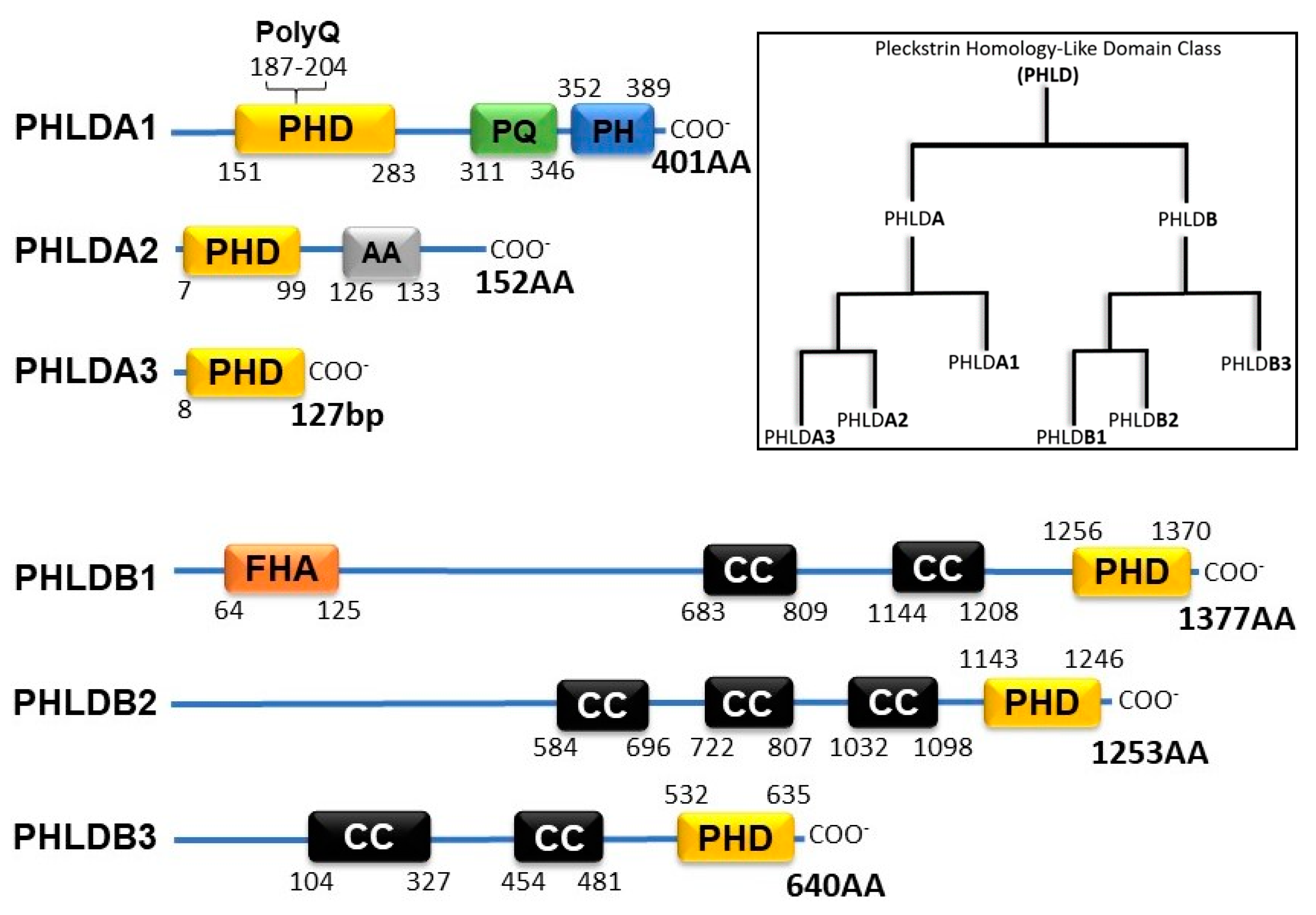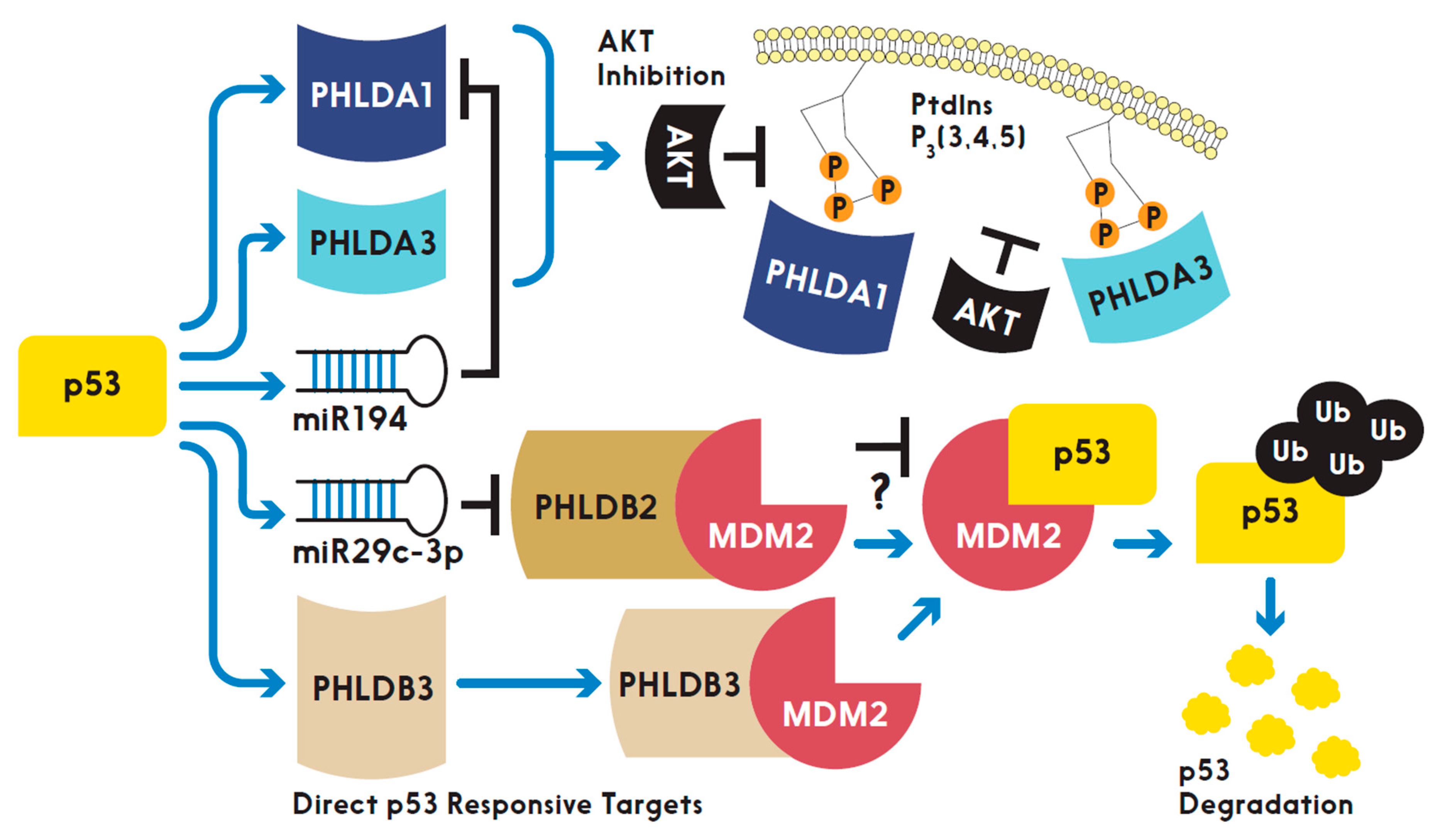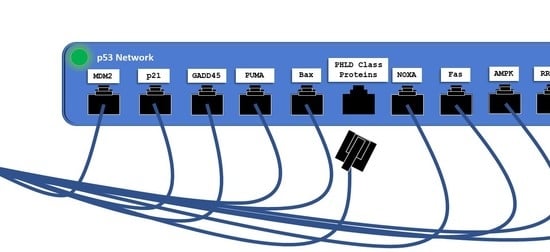PHLD Class Proteins: A Family of New Players in the p53 Network
Abstract
:1. Introduction
2. PHLD Class Proteins and Cancer
p53 and the PHLD Class Proteins
3. Prospects and More Questions
Author Contributions
Funding
Acknowledgments
Conflicts of Interest
References
- Haslam, R.J.; Koide, H.B.; Hemmings, B.A. Pleckstrin domain homology. Nature 1993, 363, 309–310. [Google Scholar] [CrossRef] [PubMed]
- Lemmon, M.A. Domains and Phosphoinositides. Biochem. Soc. Symp. 2007, 74, 81–93. [Google Scholar] [CrossRef]
- Dowler, S.; Currie, R.A.; Campbell, D.G.; Deak, M.; Kular, G.; Downes, C.P.; Alessi, D.R. Identification of pleckstrin-homology-domain-containing proteins with novel phosphoinositide-binding specificities. Biochem. J. 2000, 351, 19–31. [Google Scholar] [CrossRef] [PubMed]
- Durocher, D.; Jackson, S.P. The FHA domain. FEBS Lett. 2002, 513, 58–66. [Google Scholar] [CrossRef] [Green Version]
- Park, C.G.; Lee, S.Y.; Kandala, G.; Lee, S.Y.; Choi, Y. A Novel Gene Product that Couples TCR Signaling to Fas(CD95) Expression in Activation-Induced Cell Death. Immunity 1996, 4, 583–591. [Google Scholar] [CrossRef] [Green Version]
- Frank, D.; Mendelsohn, C.L.; Ciccone, E.; Svensson, K.; Ohlsson, R.; Tycko, B. A novel pleckstrin homology-related gene family defined by Ipl/Tssc3, TDAG51, and Tih1: Tissue-specific expression, chromosomal location, and parental imprinting. Mamm. Genome 1999, 10, 1150–1159. [Google Scholar] [CrossRef]
- Nagai, M.A. Pleckstrin homology-like domain, family A, member 1 (PHLDA1) and cancer. Biomed. Rep. 2016, 4, 275–281. [Google Scholar] [CrossRef] [Green Version]
- Ren, L.; Mendoza, A.; Zhu, J.; Briggs, J.W.; Halsey, C.; Hong, E.S.; Burkett, S.S.; Morrow, J.J.; Lizardo, M.M.; Osborne, T.; et al. Characterization of the metastatic phenotype of a panel of established osteosarcoma cells. Oncotarget 2015, 6, 29469–29481. [Google Scholar] [CrossRef] [Green Version]
- Liu, L.; Shi, Y.; Shi, J.; Wang, H.; Sheng, Y.; Jiang, Q.; Chen, H.; Li, X.; Dong, J. The long non-coding RNA SNHG1 promotes glioma progression by competitively binding to miR-194 to regulate PHLDA1 expression. Cell Death Dis. 2019, 10, 463. [Google Scholar] [CrossRef] [Green Version]
- Totzeck, F.; Andrade-Navarro, M.A.; Mier, P. The Protein Structure Context of PolyQ Regions. PLOS ONE 2017, 12, e0170801. [Google Scholar] [CrossRef]
- Chen, Y.; Takikawa, M.; Tsutsumi, S.; Yamaguchi, Y.; Okabe, A.; Shimada, M.; Kawase, T.; Sada, A.; Ezawa, I.; Takano, Y.; et al. PHLDA1, another PHLDA family protein that inhibits Akt. Cancer Sci. 2018, 109, 3532–3542. [Google Scholar] [CrossRef] [PubMed]
- Fearon, A.E.; Carter, E.P.; Clayton, N.S.; Wilkes, E.H.; Baker, A.-M.; Kapitonova, E.; Bakhouche, B.A.; Tanner, Y.; Wang, J.; Gadaleta, E.; et al. PHLDA1 Mediates Drug Resistance in Receptor Tyrosine Kinase-Driven Cancer. Cell Rep. 2018, 22, 2469–2481. [Google Scholar] [CrossRef] [PubMed] [Green Version]
- Kawase, T.; Ohki, R.; Shibata, T.; Tsutsumi, S.; Kamimura, N.; Inazawa, J.; Ohta, T.; Ichikawa, H.; Aburatani, H.; Tashiro, F.; et al. PH Domain-Only Protein PHLDA3 Is a p53-Regulated Repressor of Akt. Cell 2009, 136, 535–550. [Google Scholar] [CrossRef] [PubMed] [Green Version]
- Wang, X.; Li, G.; Koul, S.; Ohki, R.; Maurer, M.; Borczuk, A.; Halmos, B. PHLDA2 is a key oncogene-induced negative feedback inhibitor of EGFR/ErbB2 signaling via interference with AKT signaling. Oncotarget 2015, 9, 24914–24926. [Google Scholar] [CrossRef] [PubMed]
- Li, G.; Wang, X.; Hibshoosh, H.; Jin, C.; Halmos, B. Modulation of ErbB2 Blockade in ErbB2-Positive Cancers: The Role of ErbB2 Mutations and PHLDA1. PLOS ONE 2014, 9, e106349. [Google Scholar] [CrossRef] [PubMed]
- Zhao, P.; Lu, Y.; Liu, L. Correlation of decreased expression of PHLDA1 protein with malignant phenotype of gastric adenocarcinoma. Int. J. Clin. Exp. Pathol. 2015, 8, 5230–5235. [Google Scholar]
- Chiu, S.-T.; Hsieh, F.-J.; Chen, S.-W.; Shu, H.-F.; Li, H. Clinicopathologic Correlation of Up-regulated Genes Identified Using cDNA Microarray and Real-time Reverse Transcription-PCR in Human Colorectal Cancer. Cancer Epidemiol. Biomark. Prev. 2005, 14, 437–443. [Google Scholar] [CrossRef] [Green Version]
- Li, Y.; Song, X.; Liu, Z.; Li, Q.; Huang, M.; Su, B.; Mao, Y.; Wang, Y.; Mo, W.; Chen, H. Upregulation of miR-214 Induced Radioresistance of Osteosarcoma by Targeting PHLDA2 via PI3K/Akt Signaling. Front. Oncol. 2019, 9, 298. [Google Scholar] [CrossRef]
- Takikawa, M.; Ohki, R. A vicious partnership between AKT and PHLDA3 to facilitate neuroendocrine tumors. Cancer Sci. 2017, 108, 1101–1108. [Google Scholar] [CrossRef] [Green Version]
- Ohki, R.; Saito, K.; Chen, Y.; Kawase, T.; Hiraoka, N.; Saigawa, R.; Minegishi, M.; Aita, Y.; Yanai, G.; Shimizu, H.; et al. PHLDA3 is a novel tumor suppressor of pancreatic neuroendocrine tumors. Proc. Natl. Acad. Sci. USA 2014, 111, E2404–E2413. [Google Scholar] [CrossRef] [Green Version]
- Li, X.; Cao, H.; Liu, Y. Genetic epidemiology and risk factors for brain tumors. J. Cent. South Univ. Med. Sci. 2018, 43, 345–353. [Google Scholar] [CrossRef]
- Kim, L.H.; Kim, J.-H.; Namgoong, S.; Cheong, H.S.; Yoon, S.-J.; Kim, E.H.; Kim, S.H.; Kim, S.H.; Chang, J.H.; Shin, H.D. A PHLDB1 variant associated with the nonfunctional pituitary adenoma. J. Neuro-Oncology 2019, 142, 223–229. [Google Scholar] [CrossRef] [PubMed]
- Chen, G.; Zhou, T.; Li, Y.; Yu, Z.; Sun, L. p53 target miR-29c-3p suppresses colon cancer cell invasion and migration through inhibition of PHLDB2. Biochem. Biophys. Res. Commun. 2017, 487, 90–95. [Google Scholar] [CrossRef] [PubMed]
- Chao, T.; Zhou, X.; Cao, B.; Liao, P.; Liu, H.; Chen, Y.; Park, H.-W.; Zeng, S.X.; Lu, H. Pleckstrin homology domain-containing protein PHLDB3 supports cancer growth via a negative feedback loop involving p53. Nat. Commun. 2016, 7, 13755. [Google Scholar] [CrossRef] [Green Version]
- Wang, K.-W.; Dong, M. Role of circular RNAs in gastric cancer: Recent advances and prospects. World J. Gastrointest. Oncol. 2019, 11, 459–469. [Google Scholar] [CrossRef]
- Gomes, A.N.D.M.; Nagai, M.A.; Lourenço, S.V.; Coutinho-Camillo, C.M. Apoptosis and proliferation during human salivary gland development. J. Anat. 2019, 234, 830–838. [Google Scholar] [CrossRef]
- Viana-Pereira, M.; Moreno, D.A.; Linhares, P.; Amorim, J.; Nabiço, R.; Costa, S.; Vaz, R.; Reis, R.M. Replication of GWAS identifies RTEL1, CDKN2A/B, and PHLDB1 SNPs as risk factors in Portuguese gliomas patients. Mol. Boil. Rep. 2019, 47, 877–886. [Google Scholar] [CrossRef]
- Chen, G.; Zhou, T.; Ma, T.; Cao, T.; Yu, Z. Oncogenic effect of PHLDB2 is associated with epithelial-mesenchymal transition and E-cadherin regulation in colorectal cancer. Cancer Cell Int. 2019, 19, 184. [Google Scholar] [CrossRef]
- Seetharaman, S.; Etienne-Manneville, S. Microtubules at focal adhesions - a double-edged sword. J. Cell Sci. 2019, 132, jcs232843. [Google Scholar] [CrossRef] [Green Version]
- Qin, A.; Johnson, A.; Ross, J.S.; Miller, V.A.; Ali, S.M.; Schrock, A.B.; Gadgeel, S.M. Detection of Known and Novel FGFR Fusions in Non–Small Cell Lung Cancer by Comprehensive Genomic Profiling. J. Thorac. Oncol. 2019, 14, 54–62. [Google Scholar] [CrossRef] [Green Version]
- Nesterov, A.; Lu, X.; Johnson, M.; Miller, G.J.; Ivashchenko, Y.; Kraft, A.S. Elevated Akt Activity Protects the Prostate Cancer Cell Line LNCaP from TRAIL-induced Apoptosis. J. Boil. Chem. 2001, 276, 10767–10774. [Google Scholar] [CrossRef] [PubMed] [Green Version]
- Braun, C.J.; Zhang, X.; Savelyeva, I.; Wolff, S.; Moll, U.M.; Schepeler, T.; Ørntoft, T.F.; Andersen, C.L.; Dobbelstein, M. p53-Responsive micrornas 192 and 215 are capable of inducing cell cycle arrest. Cancer Res. 2008, 68, 10094–10104. [Google Scholar] [CrossRef] [PubMed] [Green Version]
- Saraon, P.; Grozavu, I.; Lim, S.H.; Snider, J.; Yao, Z.; Stagljar, I. Detecting Membrane Protein-protein Interactions Using the Mammalian Membrane Two-hybrid (MaMTH) Assay. Curr. Protoc. Chem. Boil. 2017, 9, 38–54. [Google Scholar] [CrossRef] [PubMed]
- Yamamoto, E.; Kalli, A.C.; Yasuoka, K.; Sansom, M.S. Interactions of Pleckstrin Homology Domains with Membranes: Adding Back the Bilayer via High-Throughput Molecular Dynamics. Struct. 2016, 24, 1421–1431. [Google Scholar] [CrossRef] [PubMed] [Green Version]
- Zhou, Q.L.; Jiang, Z.Y.; Mabardy, A.S.; Del Campo, C.M.; Lambright, D.G.; Holik, J.; Fogarty, K.E.; Straubhaar, J.; Nicoloro, S.; Chawla, A.; et al. A Novel Pleckstrin Homology Domain-containing Protein Enhances Insulin-stimulated Akt Phosphorylation and GLUT4 Translocation in Adipocytes*. J. Boil. Chem. 2010, 285, 27581–27589. [Google Scholar] [CrossRef] [Green Version]
- Robey, R.B.; Hay, N. Is Akt the “Warburg kinase”?—Akt-energy metabolism interactions and oncogenesis. Semin. Cancer Boil. 2008, 19, 25–31. [Google Scholar] [CrossRef] [Green Version]


| Expression Level in Normal Tissues * | Expression Level in Disease | References | |
|---|---|---|---|
| PHLDA1 | All Tissues ↑ Salivary Glands | ↓ Breast Cancer | [7,11,12,15] |
| ↓ Ovarian Cancer | [7,11] | ||
| ↓ Endometrial Cancer | [7,12] | ||
| ↓ Lung Cancer | [15] | ||
| ↓ Gastric Cancer | [7,16] | ||
| ↑ Colorectal Cancer | [7,17] | ||
| ↑ Osteosarcoma | [7,8] | ||
| PHLDA2 | Many Tissues ↑ Placenta | ↓ Breast Cancer | [14] |
| ↓ Lung Cancer | [14] | ||
| ↓ Osteosarcoma | [18] | ||
| PHLDA3 | All Tissues | ↓ Lung Cancer (Neuroendocrine Tumor) | [13] |
| ↓ Pancreatic Cancer (Neuroendocrine Tumor) | [19,20] | ||
| PHLDB1 | Many Tissues ↑ Brain | SNPs ↑ Brain Cancer | [21,22] |
| PHLDB2 | Many Tissues ↑ Placenta | ↑ Colorectal Cancer | [23] |
| PHLDB3 | All Tissues | ↑ Colorectal Cancer | [24] |
© 2020 by the authors. Licensee MDPI, Basel, Switzerland. This article is an open access article distributed under the terms and conditions of the Creative Commons Attribution (CC BY) license (http://creativecommons.org/licenses/by/4.0/).
Share and Cite
Fuselier, T.T.; Lu, H. PHLD Class Proteins: A Family of New Players in the p53 Network. Int. J. Mol. Sci. 2020, 21, 3543. https://doi.org/10.3390/ijms21103543
Fuselier TT, Lu H. PHLD Class Proteins: A Family of New Players in the p53 Network. International Journal of Molecular Sciences. 2020; 21(10):3543. https://doi.org/10.3390/ijms21103543
Chicago/Turabian StyleFuselier, Taylor T., and Hua Lu. 2020. "PHLD Class Proteins: A Family of New Players in the p53 Network" International Journal of Molecular Sciences 21, no. 10: 3543. https://doi.org/10.3390/ijms21103543
APA StyleFuselier, T. T., & Lu, H. (2020). PHLD Class Proteins: A Family of New Players in the p53 Network. International Journal of Molecular Sciences, 21(10), 3543. https://doi.org/10.3390/ijms21103543






